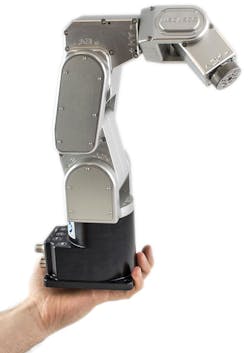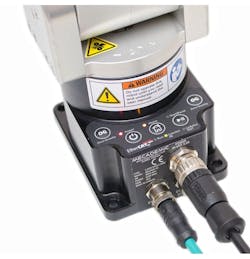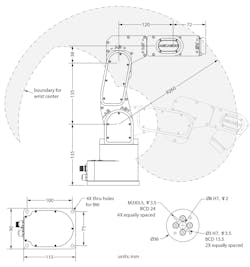The Meca500: Small and Ready to Conquer the Robot World
Jonathan Coulombe and Ilian Bonev founded Mecademic in 2013. The two met at the ÉTS engineering university in Montreal, where Bonev is a professor. Together, they developed a training robot for colleges and universities before taking a step further with Mecademic. Their goal was to develop an industrial robot that was smaller, more precise, and more intuitive to operate than any of the existing industrial models.
The Meca500—only half the size of a regular industrial robot—has six degrees of freedom . The robot is so small and light that it fits in the palm of your hands.
Three years later, Bonev and Coulombe designed the Meca500—a robot arm with six degrees of freedom and only half the size of a regular industrial robot. It weighs a mere five kilograms (11 pounds) and the base is about the size of your palm. Nevertheless, it has a load capacity of 500 grams, which is the equivalent to a stack of 200 pennies. The controller is integrated into the base, saving even more space and drastically simplifying operation. It only takes a 24-V power supply, a computer, and an Ethernet cable to program and operate the Meca500. Below is a video demonstration of the Meca500:
Flat Motors for Compact Size
Ilian Bonev is proud of his development: “It was quite a challenge to fit all the components into such a small space.” The drives needed to be small, powerful, and compliant with high-quality standards. “They simply have to be the best in terms of precision and long service life. After all, they must run for several years in continuous operation.”
The Meca500 uses brushless flat motors from maxon motor. The EC series motors range in size from 9 to 90 mm in diameter, weigh between 30-70 g, and offer high torque well-suited for robotic applications.
That’s why Mecademic decided to use brushless flat motors from maxon. These dc motors are renowned for their compact design and high torque. In the Meca500, they are combined with zero-backlash gearheads and high-resolution encoders for precise movements. The robot arm has a repeatability of 0.005 millimeters—20 times less than the thickness of a sheet of printing paper.
Easy Programming and Future Firmware Updates
“Our goal is to create a new market for industrial robots and automation,” says Ilian Bonev. In the minds of its creators, the Meca500 is only the starting point for a whole line of robots. “We want to offer the smallest and most precise robots for industrial users to pave the way for new products, applications, and discoveries.”
The Meca500 is designed to be a plug-and-play device. The communication protocol is simple, with less than 50 proprietary commands. There is no software to install; simply plug the robot to computer or programmable logic controller and, in addition to the command protocols, begin to program using your preferred computer programming language (i.e., Java, C#, Python, etc.).
Meca500’s controller is embedded in its palm-sized base. The lack of an external controller cabinet or external cables suits the Meca500 for small, confined spaces.
The robot can also be controlled via a web interface accessed via any web browser. The web interface provides access to a jogging window, allowing for control of the robot via the arrow keys, a 3D representation of the robot, and a programming window. The user can import other STEP models in the 3D environment, which is useful for applying an end effector tool to the model.
Mecademic handles the production of robot arms in-house to ensure quality. The startup currently employs eight people. They machine the aluminum parts of the robot arm on precision equipment and assemble the components in-house.
The Meca500 has a max payload of 500 grams and weighs 4.5 kilograms. Its robotic capabilities include a 260-mm reach.
New types of robots are already being developed. The startup is also working on a gripper for the arm. Customers receive firmware updates as soon as they become available. With these updates, the Meca500 will soon be able to function as a collaborative robot, with a force-limiting function to prevent collisions and a zero gravity mode.
Many other applications are possible—the robot arm is ideal to perform pick-and-place or inspection tasks. Overall, the precision of the robotic arm in a compact package provides machine builders and automation engineers with an effective tool, especially in the fields of medical research and lab automation.





